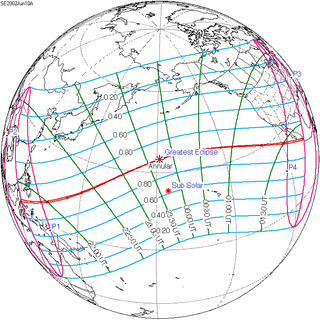| Solar eclipse of June 10, 2002 | |
|---|---|
 Partial from Los Angeles, California | |
| Type of eclipse | |
| Nature | Annular |
| Gamma | 0.1993 |
| Magnitude | 0.9962 |
| Maximum eclipse | |
| Duration | 23 s (0 min 23 s) |
| Coordinates | 34°30′N 178°36′W / 34.5°N 178.6°W |
| Max. width of band | 13 km (8.1 mi) |
| Times (UTC) | |
| Greatest eclipse | 23:45:22 |
| References | |
| Saros | 137 (35 of 70) |
| Catalog # (SE5000) | 9513 |
An annular solar eclipse occurred at the Moon's ascending node of orbit between Monday, June 10 and Tuesday, June 11, 2002,[1] with a magnitude of 0.9962. A solar eclipse occurs when the Moon passes between Earth and the Sun, thereby totally or partly obscuring the image of the Sun for a viewer on Earth. An annular solar eclipse occurs when the Moon's apparent diameter is smaller than the Sun's, blocking most of the Sun's light and causing the Sun to look like an annulus (ring). An annular eclipse appears as a partial eclipse over a region of the Earth thousands of kilometres wide. Occurring about 6.4 days after apogee (on June 4, 2002, at 14:00 UTC), the Moon's apparent diameter was smaller.[2]
This was the second annular solar eclipse visible over the Pacific Ocean within 6 months.
Annularity was visible in Indonesia, Palau (Kayangel Atoll), and the Northern Mariana Islands on June 11 (Tuesday), and the western tip of Jalisco, Mexico, on June 10 (Monday). A partial eclipse was visible for parts of eastern Asia, northeastern Australia, North America, and Hawaii.
It was partially visible in some areas of the United States; in Ventura, in southern California, some observation stations were set up for public viewing.[3] In Palm Desert, in the Coachella Valley, it was clearly visible, and it "got dark, it got cool, and it got eerie".[4]A "solar eclipse party" in Fresno drew around 400 attendees,[5] and as far north as Napa Valley, dozens of people went outside to watch the eclipse.,[6] and it was visible in Utah.[7] Canada's National Post predicted a "substantial crowd" for Vancouver, despite the eclipse there being less than 60%;[8] even in Victoria, where the eclipse was as low as 30%, dozens attended a show at the Dominion Astrophysical Observatory.[9]
- ^ "June 10–11, 2002 Annular Solar Eclipse". timeanddate. Retrieved 11 August 2024.
- ^ "Moon Distances for London, United Kingdom, England". timeanddate. Retrieved 11 August 2024.
- ^ Cite error: The named reference
Ventura County Star 2002-06-10 p11was invoked but never defined (see the help page). - ^ Cite error: The named reference
Desert20020611p11was invoked but never defined (see the help page). - ^ Cite error: The named reference
fresneauxwas invoked but never defined (see the help page). - ^ Cite error: The named reference
napawas invoked but never defined (see the help page). - ^ Cite error: The named reference
specwas invoked but never defined (see the help page). - ^ Cite error: The named reference
canadawas invoked but never defined (see the help page). - ^ Cite error: The named reference
celestwas invoked but never defined (see the help page).
